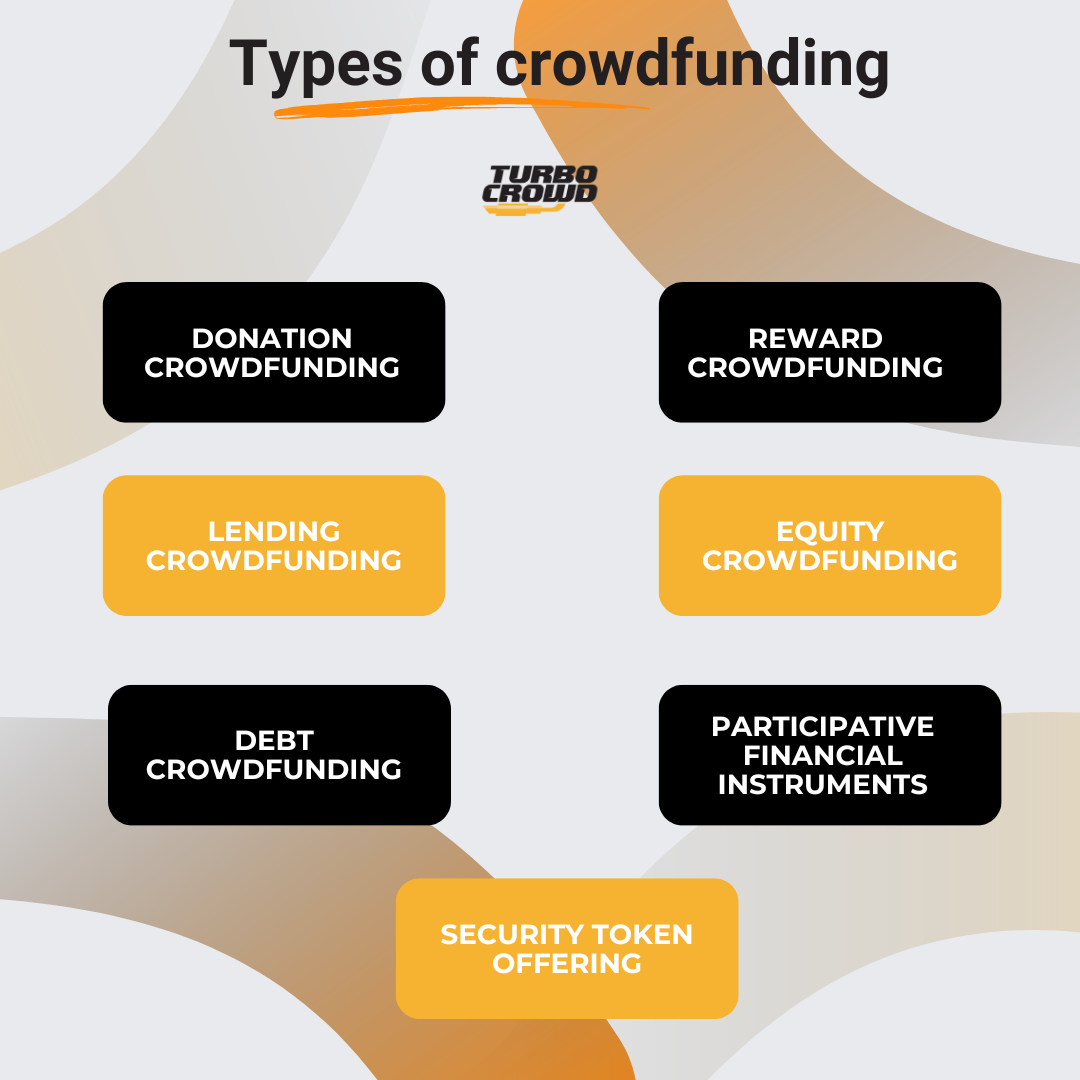- Donation crowdfunding
- Reward crowdfunding
- Lending crowdfunding
- Equity crowdfunding
- Debt crowdfunding
- The new frontiers of crowdfunding: Participatory Financial Instruments and Tokens
- Types of crowdfunding: which one to choose?
- Want to learn more directly with our crowdfunding experts about the topic you are reading about?
- Do you need support in preparing a successful crowdfunding campaign and seeking potential investors for your project?
Since the introduction of crowdfunding in Italy to date, many different types of crowdfunding have emerged, some have been added that did not exist before thanks to the development of regulations, and others have specialized in specific business areas. Knowing all the types of crowdfunding available to startups and SMEs and their characteristics is the first step in understanding which one is most suitable to the needs of your business or business idea.
Crowdfunding made its first, timid appearance in Italy as early as 2005, although only in an amateur form, with the historical platformProduzioni dal Basso, which is still active today. It was only after the phenomenon had gained traction in the United States that it began to take hold more structurally in Italy, starting from the 2010s. If you want, you can delve into the entire history of crowdfunding, which we will quickly summarize in the next few paragraphs in its most recent stages.
The types of crowdfunding that played a significant role in this development were reward crowdfunding and donation crowdfunding, following the success of American platforms like Kickstarter, which allowed financing the development of new products by pre-purchasing them before their market launch or making donations for charitable projects. Concurrently, although at a slower pace, the experimentation with the first forms of lending crowdfunding began, initially known as "social lending," which involved a "social" loan gathered from numerous individuals on the web. It was the first type of crowdfunding that offered financial returns to campaign participants through interest on the loan.
Starting from 2012, equity crowdfunding entered the Italian crowdfunding scene, bringing an unprecedented level of user involvement in the projects they finance. Apart from being investors expecting financial returns, those who participate in an equity crowdfunding campaign become shareholders of the company that launched the campaign. This results in an unparalleled level of investment risk and significant effects on the structure of the proposing companies, capturing the attention of Italian financial authorities.
This leads to a turning point: in 2013 Consob drafts the first official regulation for equity crowdfunding at the European level, aimed at protecting investors and regulating platforms and companies. It is with amendments to this regulation that in 2019 debt crowdfunding was added to the types of crowdfunding listed so far, allowing the placement of bonds and debt securities through crowdfunding campaigns.
Lending crowdfunding, equity crowdfunding, and debt crowdfunding differ from reward and donation crowdfunding because they involve a compensation for the capital provided by campaign participants: thus, they are referred to as crowdinvesting.
Let us now look in detail at each of the existing types of crowdfunding.

Donation crowdfunding
This is the crowdfunding model based on the emotional, moral, and empathetic involvement of participants, who are called upon to support a social, ethical, environmental cause without receiving any material reward in return. Sometimes there is a symbolic reward, such as donors' names published in books, websites or plaques, and usually the initiators of donation crowdfunding campaigns are nonprofit or similar organizations.
Reward crowdfunding
Reward crowdfunding involves the collection of economic resources for the development of a project that offers supporters a prize (reward) in return: usually the project consists of the creation of a new product and the prize is the product itself, which supporters receive in advance of its market launch, or on favorable terms or in an exclusive, limited version. The possible configurations of the reward are almost endless. This type of crowdfunding is particularly effective in creating a community of customers, supporters and fans and is ideal for tech or creative products. It is a way not only to raise capital, but also to market test and market in an innovative and competitive way. Find out how they work and which are the best reward crowdfunding platforms.
Lending crowdfunding
Lending crowdfunding has had several names: from "social lending" to "peer-to-peer lending" to the most widely used today, which is the one we adopt in this article. The concept, however, is always the same: an online raising of capital through a loan provided by many different individuals rather than by a bank. Thus, the hierarchical relationship between lender and recipient is broken: it is peer-to-peer lending. As it has spread as a tool for businesses and not just for individual projects, it has seen the investor base expand to include legal entities.
The great advantage of lending crowdfunding is the rapidity with which it achieves liquidity, compared to other lending channels. It is particularly appreciated by the real estate industry.
As with a bank loan, the repayment of the capital raised in lending crowdfunding also includes the payment of interest at regular intervals according to a predetermined rate. Therefore, in order to launch a lending crowdfunding campaign, you must demonstrate your ability to sustain and repay the debt. Find out how they work and which are the best lending crowdfunding platforms.
Want to learn more directly with our crowdfunding experts about the topic you are reading about?
Turbo Crowd can reveal to you all the tricks of the crowdfunding trade, explain the capital-raising opportunities available to you, and provide you with practical support to carry out a successful crowdfunding campaign.
Equity crowdfunding
Equity crowdfunding offers startups and SMEs the opportunity to sell equity shares to raise capital. Those who participate in equity crowdfunding campaigns become shareholders of the startup or SME they choose to finance, acquiring a proportional stake based on the capital invested. The financial return on the investment will mainly come from profit distribution (which, in the case of startups in Italy, cannot occur before 5 years from the company's establishment), the sale of the company, or the sale of the shares.
Equity crowdfunding is the most complex type and the favorite of startups. However, it can also be used as a “shortcut” to achieve an IPO, with crowdfunding listing, so it is also an attractive tool for large and structured companies.
Find out how they work and which are the best equity crowdfunding platforms.
Debt crowdfunding
The most recent addition among all types of crowdfunding allows listed or unlisted SMEs to place debt securities (bonds, notes, minibonds, etc.) through a crowdfunding campaign primarily targeting professional investors but also certain categories of retail investors. The company recognizes an interest rate to investors who purchase these securities, disbursed through periodic coupons, in addition to the repayment of the capital upon the maturity of the security.
The new frontiers of crowdfunding: Participatory Financial Instruments and Tokens
Innovation does not stop: new types of financial instruments that can be placed through crowdfunding campaigns to raise capital are emerging. The first, already in use, are Participatory Financial Instruments, particular debt or equity securities that can be sold to selected investors on customized terms: we have discussed them extensively here.
The second, still being studied and tested, are tokens, which are digital assets that disproportionately expand the nature of securities that companies can offer to their potential investors to raise capital. Token placement campaigns take the form of Security Token Offerings. We discussed this in our article on tokenization.
Types of crowdfunding: which one to choose?
Each of the types of crowdfunding listed has specifics that help you choose the one best suited to your situation.
Leaving aside donation crowdfunding, which mainly concerns nonprofit entities, the easiest type to attribute is reward crowdfunding: it is the ideal avenue for businesses that sell physical products and need resources for the implementation or promotion of novelties or to expand their market. This is not to say that reward crowdfunding in absolute terms is not a viable avenue for those involved in digital services or products, it can be just as useful but more complex to apply.
Lending crowdfunding is a very viable choice for those who need resources quickly for a specific goal because the campaigns are generally faster compared to equity crowdfunding and require fewer bureaucratic formalities. It is open to all categories of companies, not just startups and SMEs, and has become especially established as a financial tool to support real estate projects.
Equity crowdfunding, on the other hand, is particularly suitable for startups and SMEs that want to raise substantial financial resources for medium- to long-term development plans.
Finally, debt crowdfunding is reserved for companies in a more advanced stage of their growth journey, specifically for SMEs, including unlisted ones, with a well-established internal governance structure and potentially the prospect of listing on the market in the future.
The most innovative types of crowdfunding are open to all categories of companies and are particularly suited to those that need high customization of capital raising.
These pointers are general, and each company should start from them and then evaluate its own specific situation. Our first advice is to try the Crowdometer to see if crowdfunding is a good fit for your project!
Do you need support in preparing a successful crowdfunding campaign and seeking potential investors for your project?
Turbo Crowd can accompany you throughout the process, from organizing the precrowd to closing the collection, developing effective and innovative marketing strategies to best promote your campaign.













































